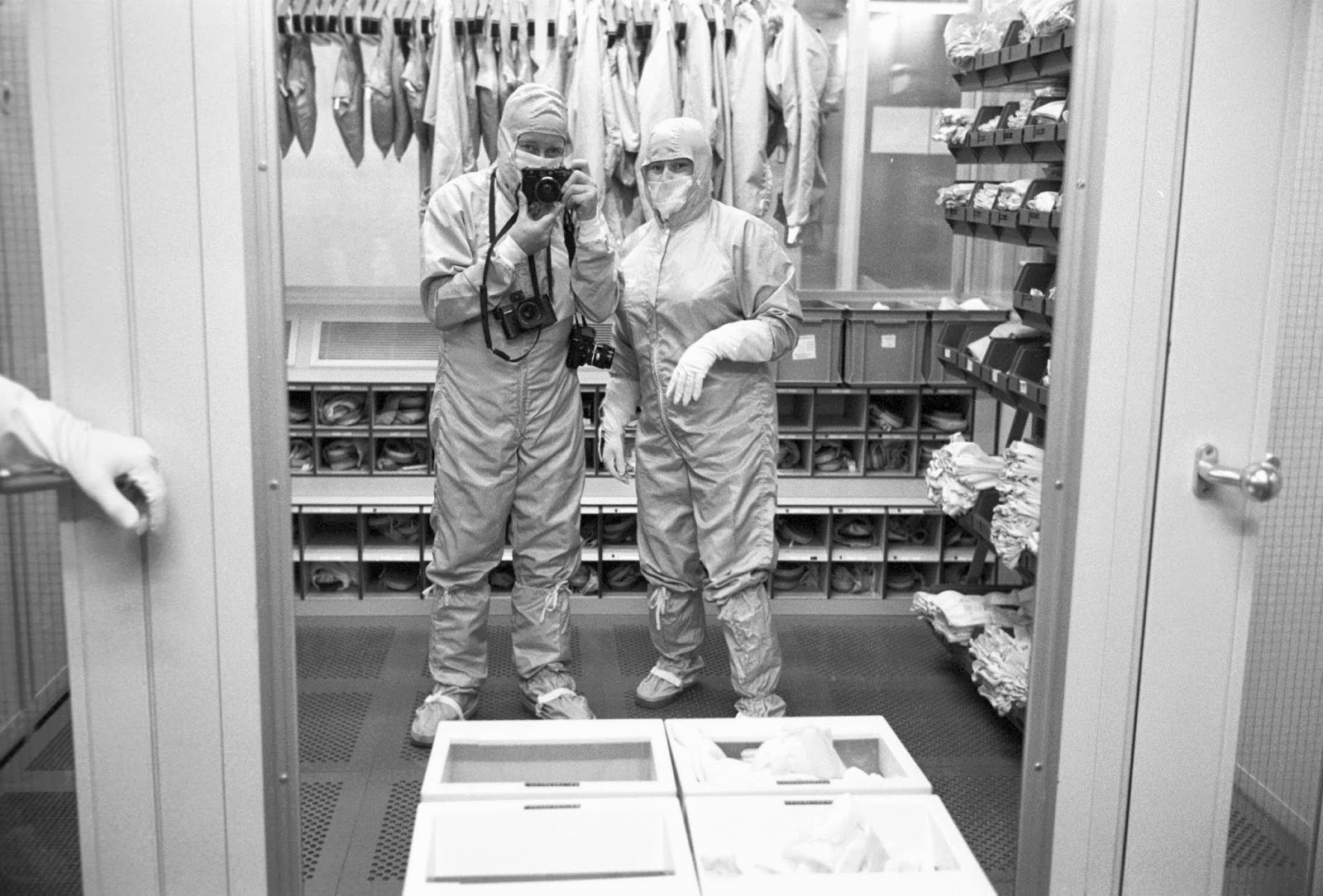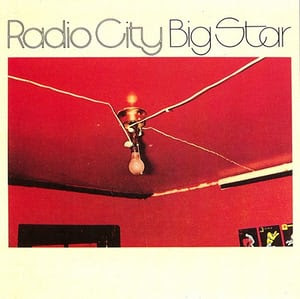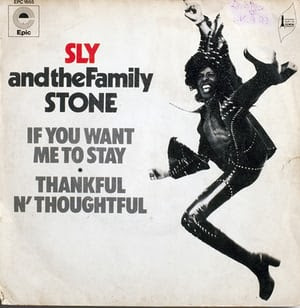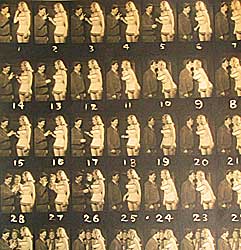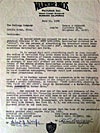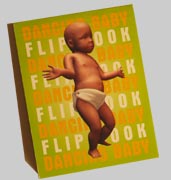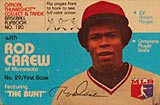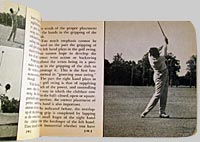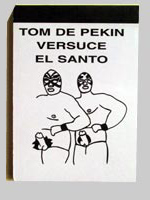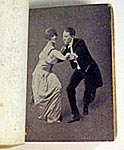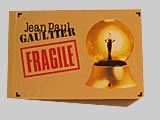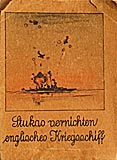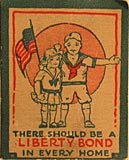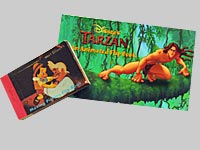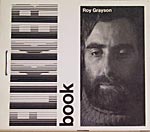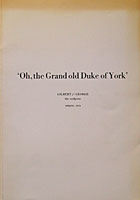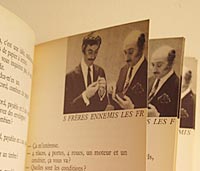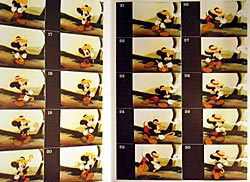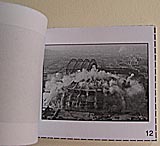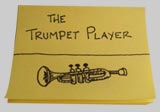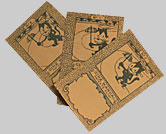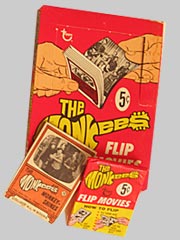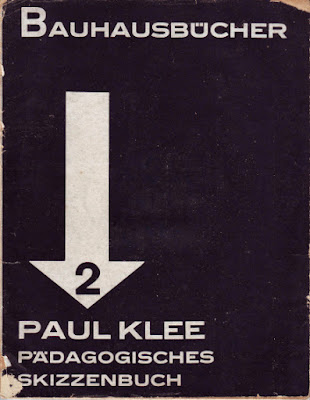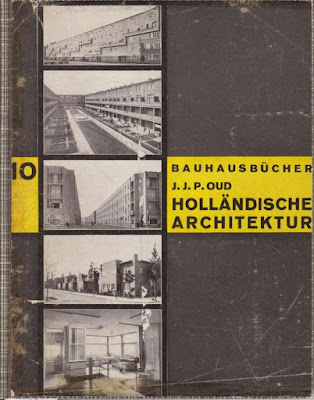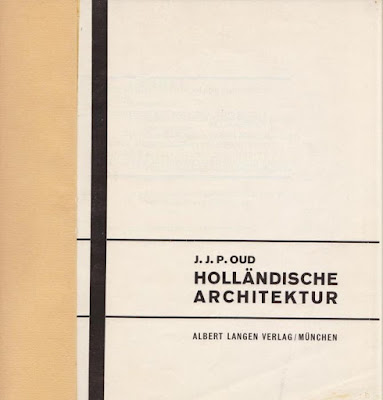Whether on a Facebook profile or in a family photo album, we use photographs to tell the stories of our lives. In a similar way, photographs also tell the grand narratives of peoples and nations, although with much more complexity and on a much larger scale. In a sense, The Chinese Photobook, on view at the Aperture Foundation’s gallery space, is China’s own family photo album, spanning the years from 1900 to 2014. (A photobook is a book whose content is primarily composed of photographs and is sometimes a coffee-table book.) Some of the photographs on display are celebratory while others are critical. Some are elegant while others are unsettling. Images captured from vastly different points of view come together to tell the rich, layered, and multifaceted story of this nation. But this diverse show also has great unity, for despite their differences, all the images demonstrate the immense social and political power of photographs.
The show is put together rigorously and meticulously. The detailed descriptive plaques that accompany each photobook reflect thorough research and help viewers place the images in their social, historical, and political contexts. (No need to be an expert on 20th century Chinese history!) Published by Americans, Europeans, Japanese, and the Chinese, these books were intended for audiences ranging from curious American children to Italian fascists, and from Maoist devotees to political dissidents. Each book tells a different story of China.
This exhibition is certainly worth a visit—even for those who have little interest in Chinese history—because it speaks to the social and political power of photographic expression, a power that is not limited to a single country, but rather is shared by all of us, even today. This exhibition demonstrates how politicians and activists use imagery to shape how people think. Do we support the illustrious Chairman Mao, to the point where we deface photographs of opposing leaders? Must we forget the Tiananmen Square Massacre, if there are no images to remind us of the event? The Chinese Photobook prompts us to reflect upon how images shape our perception of political leaders and historical events, and how photographs can be both oppressive and liberating.
In samenwerking met de Britse documentairefotograaf en verzamelaar Martin Parr (1952) werkte WassinkLundgren de afgelopen jaren aan een overzicht van geschiedkundig belangrijke Chinese fotoboeken die sinds 1900 zijn verschenen. Parr richtte zich aanvankelijk op propagandaboeken en sociaal-realistische fotografie. Dat vond Lundgren niet zo’n goed idee, liet hij onlangs in de NRC weten. Zo’n boek zou vooral de westerse vooroordelen over China bevestigen. Vanaf toen werd het blikveld verbreed. Ook fotografische pioniers, die het land aan het begin van de 20ste eeuw in beeld brachten, tot hedendaagse fotoboeken van opkomende Chinese talenten maken nu deel uit van de verzameling.
Het project van Martin Parr en WassinkLundgren duikt sinds een jaar af en toe als tentoonstelling op. Vorig jaar was een overzicht van Chinese fotoboeken te zien tijdens het fotofestival in Arles, en begin dit jaar in de
Aperture Gallery in New York. Momenteel is de tentoonstelling te bezoeken in het
Ullens Center for Contemporary Art in Beijing en in de
Photographer’s Gallery in Londen.
Ruben Lundgren of WassinkLundgren, on "The Chinese Photobook" from
Aperture Foundation on
Vimeo.
Published by Veenman Publishers, 2007
![]()
![]()
![]()
![]()
![]()
![]()
![]()
![]()
CATLEEN (THORBECKE), ELLEN. - Peking Studies. Sketches by F. H. Schiff.
Shanghai, Kelly & Walsh, 1934. Folio. 87pp. With numerous photographic illustrations by Catleen and coloured plan and illustrations by Schiff. Orig. pict. cloth with illustr. dustwrapper and transparent wrapper. First edition. - Bookseller's label on inner back cover: The Peking Bookshop. Grand Hotel des Wagon-Lits, Peking.
London, George G. Harrap & Co Ltd, 1935. 1 volume in-4, 141 pp., publishers tan paper covered boards with drawing of a chinese woman's face, 32 mounted black and white photographic portrait plates in duotone, with accompanying text, one colour illustration by Shine. A very fine copy with its dust jacket showing some tears and lack of paper on the spine. THORBECKE, E., - Hong Kong. Photographed [with the Rolleiflex Camera] and depicted. Orig. edn.
Shanghai, Kelly & Walsh, s.d. [circa], 1935. Orig. pict. col. lithographed boards with matching dustjacked, both designed and drawn by SCHIFF. Title-p. printed in red. 69pp. 23 ills. and plates, being photographs by Ellen Thorbecke, num. col. lithographed ills., of which marginal, in text and almost full-page, incl. on first free endpaper, 2 lithographed coloured plans of Hong Kong all after drawings by Schiff, text printed within a bold black border throughout, list of contents. Boards and dustjacked signed by Schiff. SCAN AVAILABLE UPON REQUEST. A lavishly and charming review of Hong Kong.
THORBECKE, ELLEN - Shanghai. Photographed and depicted by Ellen Thorbecke with sketches by Schiff.
Shanghai, North-China Daily News & Herald Ltd, [1940]. Sm.4to. 82 pp. Original decorated boards with dustwrapper. With b/w photographic plates and illustrated in colour throughout by Schiff With autograph signed dedication: "To General J.C Pabst with the polite excuses of the author for continually producing perfect horrors to serious-minded people Ellen Thorbecke Shanghai, June 1940''. - Ellen Thorbecke (1902-1973) was married to Willem J.R. Thorbecke, former Dutch ambassador to China while J.B. Pabst was ambassor to Japan during these turbulent years. Pabst had a reputation of a plain living person as Ellen was a flamboyant lady. - Friedrich Schiff (1908-1968), Austrian Jewish painter, came to China in 1930. With his watercolour works and cartoons Schiff revealed his passion for the daily life of the Chinese people during the 17 years he stayed in China.
![]()
Van der Elsken's photographs of Hong Kong show a city of extraordinary atmosphere. Taken in 1959 and 1960 - though previously unpublished - they present a city not yet overwhelmed by neon and high-rise; a city that combines a deep sense of tradition with energy in its streets which is both exhilarating and exhausting. A magnificent work of 96 duotone plates by one of the major photographers of the 20th century First edition 1997 (not to be confused with the later 2002 edition), hardcover in fine condition with near fine dust jacket with just some very slight surface wear and light handling indentations - now out of print -
Published by De Verbeelding, Amsterdam, 2001
Small 4to, 232pp. Printed wraps as issued. Numerous colour plates. Text in English and Chinese. More images available on request. For a Dutch photographer to have found her way into the intimate corners of Chinese lives must have taken more than that.". The Photographs for this book were made in China between July 1997 and May 2000. In 1994 she published 'A Hundred Summers, A Hundred Winters', a book with photographs made in Russia. This publication was met with critical acclaim and received many awards (Best Photobook of the Year, Maria Austria Prize for Best Photographer of the Year). Such a brilliant book.
Een Chinese man poseert naakt op een uitgevouwen krant in een smalle, witte ruimte. Op de grond staan een paar schoenen en twee gipsen afgietsels van een buste van een Chinese kop en van de Venus van Milo. De man kijkt de toeschouwer peinzend aan met de armen gekruist voor zijn borstkas. Zijn kwetsbare houding krijgt een echo in de halfnaakte Venus, die evenals het marmeren origineel in het Louvre geen armen meer heeft om haar geslachtsdelen af te dekken. De foto is gemaakt door Liu Zheng, een jonge Chinese fotograaf die tussen 1995 en 2000 een indrukwekkende portretgalerij aanlegde van zijn land-genoten uit verschillende provincies en bevolkingslagen van China. Welke boodschap bevat dit raadselachtige beeld? Is het een ironische confrontatie van westerse en oosterse schoonheidsidealen? De perfect geproportioneerde, blanke Venus op een sokkel versus de gerimpelde Chinese man, die armetierig op een krant staat? Of is het een cynische reflectie op de gulzigheid waarmee de artistieke avant-garde in China zich de laatste jaren op de westerse kunsttraditie heeft gestort?
Sinds in 1979 de grenzen open gingen, heeft er in China een enorme inhaalslag plaatsgevonden ten aanzien van de westerse kunst – van Dürer tot Duchamp en van Warhol tot de meest recente ontwikkelingen in Amerika en Europa. Het is verbazingwekkend om te zien met welk gemak de westerse canon door experimentele kunstenaars werd geïncorporeerd om daarmee de oude Chinese traditie nieuw leven in te blazen. China is een land met contrasten. Een land met een vijfduizend jaar oude cultuur waar de modernste kosmopolitische steden van de wereld verrijzen, maar waar tegelijkertijd miljoenen boeren in grote armoede leven. Een economische grootmacht, laverend tussen communisme en consumentisme, die open kanalen onderhoudt met de wereld maar de eigen cultuur aan een stevige censuur onderwerpt.
Sinds de jaren dertig van de vorige eeuw zijn er regelmatig Nederlandse fotografen in China geweest om te getuigen van de grote sociale omwentelingen in het voormalige keizerrijk. Bijna zonder uitzondering richtten zij hun camera op de bewoners. Zo portret-teerde Ellen Thorbecke in haar boek
People in China (1935) traditionele en moderne typen Chinezen – van ‘the concubine’ en ‘the camel-driver’ tot ‘the ultramodern girl’ en ‘the industrialist’. Haar foto’s uit begin jaren dertig reflecteren de oriëntatie op het westen onder Chiang Kai-shek. In 1959 documenteerde de communist Hans Sibbelee Mao’s ‘Grote Sprong Voorwaarts’, terwijl
Vincent Mentzel in 1973 afreisde om te getuigen van de Cultu-rele Revolutie (1966-1976).
Een van de laatsten die China intensief bezocht was Bertien van Manen. Van juli 1997 tot mei 2000 maakte zij veertien reizen langs zowel de grote steden in het oosten en zuiden (Peking, Shanghai, Shenzen, Chongqing, Chengdu en Kunmin) als dorpen op het plat-teland in het westen, niet ver van Tibet. Haar boek
East Wind West Wind (2001) geeft een impressie van het dagelijks leven binnen ‘gewone’ Chinese families en de nieuwe, lossere levensstijl van jongeren. Opvallend is de grote mate van intimiteit in haar foto’s, waarmee zij het traditionele beeld van China als een gesloten, private samenleving – ‘a country of walled cities, walled palaces, walled gardens, and walled family compounds’, zoals Ian Buruma in zijn inleiding schrijft – sterk nuanceert.
In de periode dat Bertien van Manen (1942) in China rondreisde, werkte Liu Zheng (1969) aan zijn ambitieuze reeks zwart-wit portretten van landgenoten. Veel meer nog dan het beschrijven van het moderne leven, betreft het een onderzoek naar de historische en mythologische wortels van de Chinese cultuur. In 2000 verscheen een uitgebreide selectie foto’s op zijn website onder de titel The Chinese. Het is fascinerend om te zien hoezeer zijn documentaire stilistisch en inhoudelijk afwijkt van die van Bertien van Manen en voor mij (als westerling) veel moeilijker te doorgronden is, terwijl beiden een sterk persoonlijke visie delen. Welk beeld construeren zij van het hedendaagse China? Wat ziet Liu Zheng van binnenuit anders dan Bertien van Manen van buitenaf? Wat is er zo ‘tegendraads’ aan hun werk? Met andere woorden: welke stereo-typen willen zij in de beeldvorming over China doorbreken en in hoeverre is hun blik cultureel bepaald? En hoe zit het met de inspiratie-bronnen? Zijn de foto’s in sterke mate geworteld in de eigen Chinese en westers-humanistische cultuur? Of is er ook sprake van cross-over beïnvloeding?
De mensen, de mythen en de geschiedenis
Twee clowns in Mao-pakken bij de Chinese opera, een ingepakt Boeddhabeeld, babylijkjes in een draineerbuis, een imitatie-Elvis omringd door geblondeerde danseressen, rouwende vrouwen bij een plattelandsbegrafenis en een dichteres die naakt poseert. Dit is een kleine greep uit de circa 180 zwart-wit foto’s op de website van Liu Zheng, waarin het menselijk bestaan in al zijn dramatiek wordt uitgebeeld. Al bij een eerste aanblik gaat er een verontrustende werking uit van deze esthetisch gecomponeerde beelden. De samenhang van de portretten van mensen uit de wereld van religie, theater en het échte leven ontgaat me, evenals de gecombineerde thematiek van seks en dood (eros en thanatos) en de aandacht voor de Chinese geschiedenis in foto’s van oude sculpturen. Behoren erotiek en religie niet tot de taboes in de Volksrepubliek? En waar is het moderne China zoals we dat kennen uit de westerse berichtgeving: de shoppende middenklasse, karaoke-zingende yuppies, betogende Falun Gong en zakenmensen temidden van hun glinsterende nieuwe kantoren?
Op de website introduceert Liu Zheng The Chinese als volgt: ‘It analyses the entire (Chi-nese) race drastically from three realms (the world of belief, the world of reality and the world of hell). These three realms exist in contemporary China. So, these photos are not single. In fact, they contact with each other closely. These photos are surrealistic images of China.’In een interview met de kunsthistoricus Wu Hung uit 1998 geeft Liu Zheng toelich-ting op het project, dat dan nog in een voorstadium verkeert. Hij zegt zijn foto’s te willen indelen in drie secties – de mensen, de mythen en de geschiedenis – om zo de Chinese cultuur aan een nieuw onderzoek te onderwerpen. De ‘mensensectie’ bevat een selectie portretten van ‘only those individuals who are simultaneously real and surreal, contempo-rary and transcedent’. Het belang van het theater voor zijn fotografie wordt hier evident. Liu Zheng ziet de wereld als een schouwtoneel en andersom het theater als een afspiegeling van het werkelijke leven. Hij is gefascineerd door het masker waarachter de mens zich verbergt en wil het spanningsveld blootleggen tussen het wezen van een persoon en zijn of haar publieke rol.
De ‘mythesectie’ zou oorspronkelijk worden opgezet rondom het thema van de seksuele lust. Volgens Wu Hung is het veelzeggend dat Liu Zheng de gehele premoderne fase van China identificeert als een ‘mythische periode’. Die mythes vormen al 900 jaar in allerlei variaties het hoofdthema van de Chinese opera. In barokke ensceneringen laat hij mytho-logische personages uit de Peking Opera naakt en wellustig over elkaar heen buitelen. Buiten het podium poseren verschillende acteurs en actrices als pin-ups en travestieten, waarmee de foto’s een eigentijds jaren negentig karakter krijgen. Maar ook het thema van het kwaad wordt in de mythesectie aangeroerd, in fotografische opnamen van oude sculp-turen met voorstellingen van de hel in Taoïstische tempels.
De derde ‘historische sectie’ valt samen met het modernisme van de twintigste eeuw, de periode waarin de Chinese cultuur zich sterk op het westen richt. Het is voor Liu Zheng het tijdperk van de fotografie, maar ook van de politieke strijd die in 1949 zou leiden tot het stichten van de Volksrepubliek China. Voor deze sectie was het oorspronkelijke plan om remakes te maken van beroemde historische foto’s – zeer waarschijnlijk inclusief de be-kende propagandabeelden van Mao (bij de stembus, zwemmend in de Jang-tse, etcetera) – om pas achteraf aan de toeschouwers mee te delen dat het vervalsingen zijn. Deze fake foto’s zouden ieder geloof in historische feitelijkheden moeten ondermijnen. Tot een serieuze toepassing van deze postmoderne deconstructietactiek is het niet gekomen. Wel fotografeerde Liu Zheng een monument van Mao als leider van de Rode Gardisten uit de Culturele Revolutie.
Nostalgie (huai jiu)
Op de uiteindelijke website-versie zijn de foto’s uit de drie secties volledig met elkaar vermengd, evenals de thema’s van religie, hel en werkelijkheid. The Chinese laat zich aldus lezen als een tijdloos epos over China. De foto’s lijken ook in een ver verleden gemaakt. Dat heeft in de eerste plaats zijn oorzaak in het zwart-wit, dat vandaag steeds minder gangbaar is bij fotoprojecten met een documentaire inslag. Bovendien heeft Liu Zheng zich stilistisch laten inspireren door de ‘klassieke’ portretreeksen van August Sander over de inwoners van Duitsland in de jaren van het interbellum en van Diane Arbus over de New-yorkse freaks uit de jaren zestig. Ten derde heeft hij met name op het Chinese platteland een levensstijl gefotografeerd zoals wij die in het westen nauwelijks nog kennen: een jon-gen in een schooluniform, een fabrieksmeisje achter een oude weefmachine en twee jonge acrobaten met een aapje voor een circustent. Deze beelden roepen bij ons nostalgische gevoelens op naar vroeger, naar de kinderjaren of grootmoeders tijd. Maar welke rol speelt ‘nostalgie’ in China, een land dat de afgelopen honderd jaar zo verschrikkelijk is geteisterd door armoede, oorlogen en revoluties?
Wung Hu betoogt dat Chinezen het begrip nostalgie (huai jiu) in sterke mate associëren met oude foto’s uit de eerste helft van de twintigste eeuw (dus vóór het communisme) en sinds kort ook met de Mao-memorabilia uit de periode van de Culturele Revolutie. Huai jiu (letterlijk vertaald ‘het missen van het oude’) heeft een specifiekere betekenis dan een algemeen verlangen naar vroeger. De term dient te worden onderscheiden van huai gu (‘mediteren op het verleden’). Beide benamingen kunnen in het moderne Chinees worden vertaald als ‘oud’. Jiu heeft betrekking op een meer recent en bereikbaar verleden terwijl gu verwijst naar vroegere tijden. Jiu beschrijft uitstervende en versleten dingen. Gu verwijst naar begraven of gebroken dingen. Er is dus een duidelijk verschil in tijdsgat. Huai gu betreurt vaak een voorbije keizerlijke dynastie, terwijl huai jiu betrekking heeft op het herinneren van de eigen kindertijd of jeugd.
Dit specifieke concept van huai jiu verklaart volgens Wung Hu waarom oude foto’s – meer dan oude architectuur, films, mode en affiches – in China de primaire plek voor nostalgie zijn geworden. Het verleden verwijst in historische foto’s niet naar oude keizer-lijke dynastieën, maar naar de jaren van de fotografie zelf: dat wil zeggen naar het ‘moderne verleden van een postmoderne samenleving’. Dit verleden wordt in China het best gerepresenteerd door het mondaine Shanghai van de jaren twintig en dertig, dat de naam had van het Parijs van het Verre Oosten. In zijn opera-ensceneringen, die in de oorspronkelijke plannen deel uitmaakten van The Chinese, imiteert Liu Zheng het oude en het afgesletene. Maar anders dan bij namaak-antiek vangen de fotobeelden alleen de nostalgie van de tijdsgeest en niet hun iconografie. Liu Zheng heeft nooit de behoefte om zich te identificeren met het verleden. Veel meer herdefinieert hij het nostalgische beeld van een oude foto strikt als een kunststijl, en niet als een aansporing tot een echte terugkeer naar een voorbij historisch mo-ment. Feitelijk problematiseert hij de noties van huai jiu en huai gu door beiden in de foto te leggen en zo te spelen met het oppervlakkige uiterlijk (nepantiek) versus de diepere betekenis.
Een voorbeeld is het werk Legende van de Witte Slang (1997), gebaseerd op een fabel over een witte slang die zichzelf verandert in een mooie vrouw en met haar compagnon, de groene slang, afdaalt naar de aarde, waar ze verliefd wordt op een knappe jongeman. De foto onderscheidt zich van eerdere stills uit de Peking Opera door de naaktheid van de figuren en de ‘antieke’ uitvoering. Liu Zheng heeft het beeld een bruine toon gegeven en de achtergrond voorzien van negentiende-eeuwse draperieën. Volgens Wung Hu geven deze toevoegingen een typisch jaren negentig gevoel aan het werk, terwijl de foto tegelijkertijd verwijst naar de zwoelheid van het hofleven ten tijde van de Ming dynastie (1368-1644). De expliciet erotische uitstraling van de figuren verstoort echter het verlangen tot huai jiu of nostalgie, want de kijker wordt gevangen in een heden-daagse esthetiek van kitsch.
In een groot aantal portretfoto’s in The Chinese speelt hetzelfde mechanisme, en wordt iedere vorm van sentimentaliteit teniet gedaan door seksuele toespelingen, dislocatie of een afstandelijke blik. Zo verschijnt een jonge vrouw van een van de zes etnische minderheden (welke blijft onvermeld in het bijschrift) niet in de nationale klederdracht, maar uit-dagend naakt in de studio. En staan drie oude actrices van de Peking Opera wulps met hun waaiers te lonken in een doorgang van de metro. Ook het telkens terugkerende thema van de dood ondermijnt ieder nostalgisch zwelgen in ‘het oude’. Voorbeelden zijn de foto’s van een boer in zijn grafkist en van een man gemaskerd als geest bij een volksfeest in de zuidelijke provincie Sichuan.
Anders dan Liu Zheng laat Van Manen in haar boek
East Wind West Wind zien dat de traditionele familieband nog steeds het dagelijks leven van de meeste Chinezen domineert. Onderweg verbleef zij zoveel mogelijk bij de mensen thuis om zo met haar compact camera vanuit een vriendschapsrelatie te kunnen fotograferen. De voor Chinese begrippen ongekende intimiteit komt pregnant naar voren in de talloze foto’s waarop het bed centraal staat. Het is de meest private plek die je in huis kunt bedenken en in China wordt er op geslapen, TV gekeken, gevreeën, gasten ontvangen en van gegeten. Deze documentaire benadering, waarvoor Bertien van Manen in de jaren negentig een van de trendsetters is geweest, loopt vooruit op de hedendaagse ‘lifestyle-fotografie’: het terloops met een kleine camera door middel van gestileerde momentopnamen uitbeelden van menselijke activiteiten. Vrije tijd, kleding, uiterlijk en een zelfbewuste uitstraling spelen een belangrijke rol. Net zoals in een docu-soap doen de modellen zich spontaan en naturel voor. Zij ‘spelen’ het échte leven.
Verrassend zijn de beelden van twee jongens die zich thuis bezig houden met make-up en travestie. Hiermee raakt Van Manen aan het taboe op homoseksualiteit, waarvan het bestaan door de Chinese autoriteiten nog steeds wordt ontkend. Zo is er de foto van Coco uit Shanghai cross dressing. In een bloemetjesjurk en te grote maat pumps staat de jongen onhandig te wiebelen voor de spiegel, volledig in beslag genomen door zijn zelfbeeld. Van Manen fotografeerde hem kwetsbaar op de rug. Het bed op de voorgrond en de pastel-kleuren maken het tafereel nog intiemer.
Hoe totaal anders heeft Liu Zheng travestie uitgebeeld. In ‘A man in disguise of an actress’ kijkt een acteur in pin-up houding de kijker uitdagend aan. De invulflits accentueert zijn overdadige make-up en maakt zijn glamoureuze pose volledig over the top. De cryptische titel verwijst naar de traditie van de Peking Opera, waar mannen van oudsher de vrouwenrollen spelen. Gemengde optredens waren bij wet verboden en operagezelschappen werden in China geassocieerd met homofilie. Waar Liu Zheng in zijn portret op subtiele wijze de dubbele moraal blootlegt ten aanzien van homoseksualiteit door te verwijzen naar de traditie van het Chinese theater, daar benadrukt Bertien van Manen in haar foto’s van Coco het intermenselijk contact en de vrije ontplooiing van ieder individu – centrale paradigma’s binnen het westerse humanisme.
Cross-over
Eind jaren negentig blikken Chinese avant-garde kunstenaars zowel naar binnen als naar buiten. Er is mondiaal sprake van een sterk toegenomen interconnectie tussen globaliserende invloeden en persoonlijke stellingname. Deze ontwikkeling grijpt sterker om zich heen in de ‘artistieke derde-wereldlanden’ – waartoe China zich rekent – dan in het we-sten. Liu Zheng, die deel uitmaakt van de Beijingse underground, is een echte cross-over kunstenaar. Naast de eigen culturele roots van de Peking Opera en het uit Rusland geïmporteerde sociaal realisme van de Chinese fotojournalistiek is hij naar eigen zeggen sterk beïnvloed door het werk van August Sander (1876-1964), Weegee (1899-1968) en Diane Arbus (1923-1971). Van Sander heeft Liu Zheng een objecti-verende manier van portret-teren overgenomen en de behoefte om de Chinese samenleving typologisch in te delen naar beroepen, religieuze gemeenschappen en klassen. Een voorbeeld is ‘A desert farmer with his camel’, waar een boer in werkpak in een frontale opstelling voor de camera staat met achter hem de sierlijke gestalte van zijn kameel. Net als Sander benadrukt Liu Zheng in dit portret het archaïsche karakter van het boerenleven. Mens en dier zijn innig met el-kaar verbonden en voeren als tweespan eeuwen-oude werkzaamheden uit. Pas in tweede instantie valt het oog op de lelijke stomp van zijn linkerarm, die is afgezet. Dit detail maakt het beeld schrijnend en ondermijnt – anders dan bij Sander – alle nostalgische gedachten over een harmonisch landleven of, vanuit Chinees perspectief, de boer als communistisch rolmodel.
Met Diane Arbus deelt Liu Zheng een fascinatie voor het masker en voor sprookjes en mythen. Arbusiaans in hun stijl en weirdness zijn zeker de foto’s ‘Two wealthy men in masks at Christmas Eve’ en ‘A local entertainer’. De laatste toont een jonge vrouw gekleed in een sexy turnpakje met cape, pumps en zonnebril, poserend voor een witte muur waar-op een ijslollyreclame met een jolige kabouter is geschilderd. In navolging van Arbus flitst ook Liu Zheng zijn zwart-wit foto’s regelmatig in om de personages van de achtergrond te isoleren en zo een unheimisch effect te verkrijgen. Maar waar Arbus genadeloos onthullend is in haar psychologiserende portretten van Newyorkse families, transseksuelen, circusartiesten en nudisten, daar houdt Liu Zheng meer afstand. Zijn mensen zijn minder geëmotioneerd, lijken niet zozeer aangedaan door een innerlijke gespletenheid alswel door een dosis argwaan en wantrouwen naar de buitenwereld toe.
Tenslotte verwijst de titel
The Chinese naar mijn idee naar het beroemde fotoboek
The Americans (1958) van Robert Frank. Beide fotografen hebben de tegendraadse keuze gemaakt om de schaduwzijde van het menselijke bestaan te documenteren in tijden van economische voorspoed, en zo kanttekeningen te plaatsen bij respectievelijk the American dream van de jaren vijftig en het nieuwe China van de jaren negentig. Bij Liu Zheng ontbreekt het door Frank zo fraai gevisualiseerde gevoel van ‘on the road’, ondanks dat zijn portretten op zeer uiteenlopende plekken in China zijn ontstaan.
De reportage van Bertien van Manen beweegt zich, wél in de geest van haar idool Robert Frank, tussen reisverslag en human interest. Foto’s van mensen en interieurs worden in
East Wind West Wind afgewisseld met landschappen, stadsgezichten en straatbeelden. Regelmatig fotografeerde zij door de voorruit van een auto, om een sfeerbeeld te geven van de kleurrijke stoet door elkaar heen krioelende voetgangers, fietsers, motoren en taxi’s in de Chinese steden. Een modisch gevoel komt sterk naar voren in enkele informele foto’s van jongeren. Zo fotografeerde zij een zakenvrouw met hippe bril, laptop en mobiele telefoon in de economische vrijzone Shenzhen en een meisje met ijslolly, rode lipstick en merkkleding in een winkelstraat in Beijing. Al eerder in 1996 portretteerde Van Manen op gelijksoortige wijze extravagante jongeren in Tokio. Mogelijk heeft dat haar ongedwongen snapshot stijl en belangstelling voor trendy mode onder invloed van de kleurrijke Japanse lifestyle-cultuur een extra stimulans gekregen. Maar haar belangrijkste inspiratiebronnen voor de China-foto’s liggen in het westen, bij de Amerikanen Robert Frank en William Eggleston.
Dubbele moraal
Liu Zheng en Bertien van Manen geven beiden een zeer persoonlijke visie op China, waarbij stereotypen worden ontkracht of op zijn minst genuan ceerd. Bij Liu Zheng is dat een China met sterke wortels in de mythologie, de geschiedenis en de religie, geactualiseerd door een vrijmoedige omgang met erotiek en aandacht voor de levensstijl van de jongere generatie. In de geest van Goya houdt hij zijn landgenoten een spiegel voor. Hij zoekt de scheur in hun levens: daar waar hun privé-bestaan botst met de publieke buitenkant. Het beeld dat de optelsom van portretten in
The Chinese laat zien is veel diverser dan het economisch succes waarmee de leiders van de Communistische Partij te koop lopen. Hij toont de wreedheid van de Chinese cultuur in foto’s van achtergelaten babylijkjes – een uitwas van de eenkindspolitiek. Er is aandacht voor onderdrukte religieuze groeperingen, van katholieken tot boeddhisten, voor de gediscrimineerde Chinese minderheden, bedelende kinderen, gevangenen, gehandicapten, kunstenaars en acteurs. Zijn typologie overstijgt het stereo-type beeld van de optimistische, materialistische Han-Chinees die zich een westerse levensstijl aanmeet.
Bertien van Manen heeft zich in
East Wind West Wind sterk gericht op de snelle verande ringen in menselijke relaties, levens stijlen, smaak en waarden als gevolg van de open houding naar het westen toe. Haar boek bevat geen directe kritiek op het gebrek aan democratie en politieke vrijheid in de Volksrepubliek. Er zijn geen foto’s die refereren aan het schenden van mensenrechten, het falende rechtssysteem of het met militair geweld onder-drukken van religieuze bewegingen als de Falun Gong. Dat zou te zeer een bevestiging zijn van het stereotype beeld in de westerse media. Je zou op haar serie kunnen aanmerken dat die wel een heel positieve indruk geeft van het hedendaagse China: veel kleine menselijke emoties en huiselijk geluk. Tegelijkertijd is Van Manen met haar emotionele mensbeelden erin geslaagd het afbrokkelen van het taboe op het publiekelijk uiten van gevoelens te visualiseren. Kussen, flirten en elkaar aanraken werden door de Communistische Partij tot voor kort afgedaan als ‘bourgeois-decadent’ gedrag.
Hoe sterk deze foto’s van Bertien van Manen in de westerse media tot de verbeelding spreken, blijkt uit de publicatie van een kleine selectie in ‘Das Magazin’ (juni 2001), de weekendbijlage van de Zwitserse kwaliteitskrant
Neue Zürcher Zeitung, ter illustratie van een artikel over de ‘sexuelle Revolution’ in China. De foto’s tonen ondermeer twee vrien-dinnen huilend aan de telefoon (vanwege liefdesverdriet, volgens het bijschrift) een jongen en meisje die met elkaar stoeien op hun bed en een vrijend paartje op straat in Beijing (‘Heisse Szene in Strassen-café in Peking’). De strekking van het artikel is dat seks – na jarenlang te zijn onderdrukt – nu op een glijdende schaal van plezier naar pornografie en prostitutie is terecht gekomen. Chinezen zouden nauwelijks nog in staat zijn tot intimiteiten. Daarmee botst het artikel met de intenties van Bertien van Manen, zeker ook gelet op het feit dat haar meest sensuele foto’s uit de context van
East Wind West Wind zijn gelicht. Het ergste voorbeeld is nog de foto van een oom die bij het karaoke-zingen een handkus van zijn nichtje krijgt, terwijl in de tekst wordt gerept over betaalde seks van oude mannen met hele jonge meisjes! Is hier bij
Neue Zürcher Zeitung niet sprake van een typisch westerse dubbele moraal? Enerzijds met het vingertje omhoog waarschuwen tegen inhumane omgangsvormen buiten de eigen grenzen en anderzijds een koperspubliek zich laten verlustigen aan opwindende beelden?
Een gemeen schappelijk punt bij Liu Zheng en Bertien van Manen is dat beiden nauwelijks aandacht besteden aan de werkende Chinees, de arbeider en de boer die in de tijd van Mao als rolmodellen fungeerden van de economische en maatschappelijke vernieuwing. Liu Zheng beperkt zich tot enkele ironische foto’s van mijnwerkers onder de douche; antihelden die zich het vuil van het lichaam schrobben of nonchalant poseren met een sigaret in de hand. Op een enkele uitzondering na zijn er geen beelden van ploeterende boeren, vandaag naar schatting zo’n 900 miljoen in getal sterk, waarvan minstens een derde in grote armoede leeft. Bertien van Manen zegt over deze keuze: ‘Ik heb zoveel mogelijk de clichés vermeden en geprobeerd een ander beeld van China te geven dan de spectaculaire bekende zieligheid en mooie plaatjes. Het is een persoonlijk verhaal en geen sociale documentaire.’
![]()
In dit verband is het opvallend dat ook Liu Zheng heeft laten weten wars te zijn van een sociaal-kritische stellingname, hoewel beiden zich in het verleden hebben verdiept in maatschappelijke kwesties. Liu Zheng, die opgroeide in een mijnwerkersgezin in de noordelijke provincie Shanxi, begon in 1991 als fotojournalist voor
The Workers Daily, waar hij de taak kreeg om de mijnindustrie te coveren. In 1993 richtte hij ‘TOPIC fotografie’ op en startte een serie over mensen van het Chinese platteland. Anders dan de meeste fotografen, die gecharmeerd zijn door het exotisme van de etnische minderheden, concentreerde hij zich op de benarde toestand van de Han-boer. Bertien van Manen werd eind jaren zeventig bekend met een aantal reportages over de vrouwenbeweging. Als een van de eersten documenteerde zij in Nederland het isolement van Turkse en Marokkaanse vrouwen. In 1987-88 maakte zij een reportage over mijnwerkersfamilies in hun afgelegen settlements in de Appalachian Mountains in Kentucky, USA. Een internationale doorbraak volgde met
A Hundred Summers A Hundred Winters (1994), een rondreis langs Russische families kort na de val van de Muur. In gloedvolle kleuren fotografeerde zij de interieurs en hun door armoede getekende dagelijkse levens.
Interculturele uitwisseling kan in de fotografie soms verrassend alledaags zijn. Kijk maar naar de foto die Bertien van Manen maakte van een jong, westers gekleed stel aan een tafel in een bar in Shanghai met achter hen een reproductie van het bekende schilderij van Otto Dix van de journaliste Sylvia von Harden (1926). De journaliste, die eveneens in een bar aan een tafeltje zit, toont zich met haar monocle, kort geknipt haar, sigaret en cocktail-drankje in de typisch mannelijke look van de jaren twintig – onafhankelijk, maar ook eenzaam. Het portret van Von Harden biedt lifestyle avant la lettre. Het maniërisme van haar houding vindt een pendant in de manier waarop het meisje de jongen intiem in het oor fluistert en tegelijkertijd met haar hand een afwerend gebaar maakt naar de fotografe.
Deze caféscène brengt ons terug bij de beginfoto van Liu Zheng: de naakte Chinees en de Venus van Milo. Beide beelden bevatten tekens van westerse invloeden in China. Niet alleen Oost en West, maar ook kunst en leven komen hier samen. De foto’s roepen vragen op over culturele identiteit in tijden van globalisering. Wat is typisch westers, wat is typisch Chinees? Hoe worden decadentie, (on)gewenste intimiteiten en schoonheidsnormen in verschillende landen, regio’s en tijdsperioden uitgebeeld? De Chinese kunsthistoricus Leng Lin vat het probleem in één zin samen: ‘In this postmodern existence, we fully recognize that what makes us different from others is also what gives us a place in today’s world.’
Rik Suermondt
Gepubliceerd in: Nelly van der Geest, Kitty Zijlmans, Curry. Het interculturele Kunstdebat, Hogeschool voor de Kunsten Utrecht 2002, pp 12-31 Met dank aan: Hans van Dijk (1946-2002), Sui Hong, Bertien van Manen en Bas Vroege
OTTEN, REINEKE / KOOLHAAS, CHARLIE - Otten, Reineke; China Daily Life
Rotterdam, Veenman, 2006. ng pag.. Ill. in kleur. Softcover
Reineke Otten is both an artist and a social scientist. She is an artist, because her photos capture the strange and inarticulable beauty of everyday life. And a scientist, because her goal is not merely to capture beauty, but also to assemble fragments in a way that demonstrates patterns and orders. Taking a highly structural approach, Reineke’s photography is a research method for a visual sociology. She begins her inquiries from the bottom up, observing the smallest of details and social interactions and, in using these, she suggests how larger-scale institutions operate around them. Her method intensifies a multiplicity of social relations and interactions. Reineke calls her approach
Streetology:
“I divide the visual make up of the street into hundreds of different categories and divide these images into scales. Using photography I am making a street inventory or break down. I am part of this new digital generation, who are making important documents of this century.”
- Reineke Otten
Temporary like an Ikea Catalogue
So what does it mean to be part of the digital generation? In some way it is to share the frantic need to record as a way of absorbing. The digital generation are making massive inventories of ‘everyday life’ around the world; Otten’s work comprises a fragment of this effort. It is frantic and obsessive -a demonstration of the fear that things are changing before we even have time to witness the moment or understand what’s going on. Everything is documented so that It can be digested at a later date. The digital generation are observers rather than participants, they record before they experience, and every exciting moment that isnt recorded is considered a missed opportunity.
“The quickness of the digital photography matches the rapid changes of the city.
![]()












